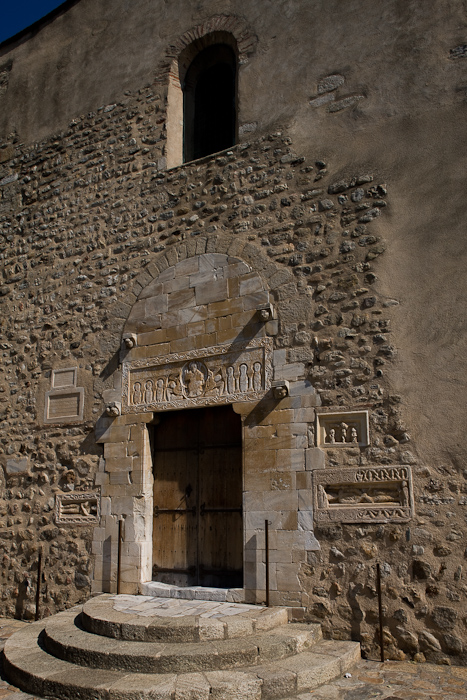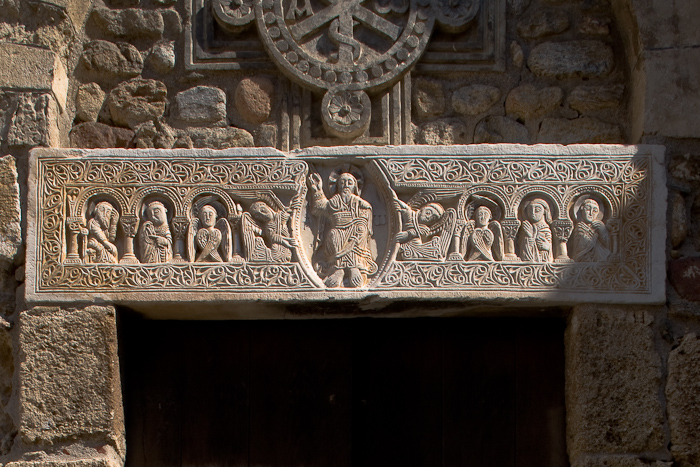Many scholars believe that the origins of the Romanesque style are found in the French department of the Pyrénées-Orientales, part of ancient Catalonia. The abbey churches at Saint Martin-du-Canigou and Saint Michel-de-Cuxa are part of this architectural renaissance. Hand-in-hand with the architectural innovation were developments in sculpture. This post will discuss two small fragments of that art just three miles apart – the west facade lintels at Saint-Génis-des-Fontaines and Saint-André-de-Sorede.
Both are bas-reliefs situated in the west portal of the churches. They are made with white Ceret marble and are believed to be among the very earliest Romanesque sculptures. That of Saint-Génis is dated by an inscription on the lintel, which reads Anno videsimo rege Wilielmvs Dei gratia aba isa opera in honovr fieri ivssit sancti genesii cenobii that vocant Fontanas. This translates to “The twenty-fourth year of the reign of King Robert, abbot Guilhem by the grace of God, ordered to do this work in honor of Saint Genis monastery called Fontaines.” The year referred to is 1020.

The lintel at Saint-André-de-Sorede is located in approximately the same position on the west facade and is roughly contemporaneous to that at Saint-Génis-des-Fontaines. While the Saint-Génis lintel is set into a rebuilt facade, the Saint-André facade is original and contains other sculptures in the ensemble. But there are some who have noted that the lintel is the exact same length as the altar table within and have suggested that it was originally carved as part of that altar arrangement and only later placed in the portal.

The Saint-Génis lintel is carved in fairly shallow bas-relief. In the center there is a representation of Christ in Majesty – seated in a mandorla supported by two archangels and surrounded by two groups of three apostles, each housed in a horseshoe arch. On both sides of the mandorla is a band bearing the Anno videsimo rege Wilielmvs inscription in medieval Latin.

For a more detailed view of the lintel, click here.
There seems to be a difficulty for scholars to identify the stylistic influences on the sculpture. Kingsley Porter alone has identified that the Saint-Génis lintel is influenced by Near-Eastern, Byzantine, Ottonian, Spanish, and native Catalonian sources. One thing is sure, however, is that it is among the very earliest examples of the style we call “Romanesque”.
The Saint-André lintel is almost identical in content. The Christ in mandorla is flanked by four angels and four half-figures of saints. The poses, designs, and decorations could be made from exact same source used in Saint-Génis.

For a more detailed view of the lintel, click here.
Because of the identical subject matter and the fact that the churches are only three miles apart, some scholars are convinced that the lintels were carved by the same person. John Kenneth Conant disagrees. He believes that while contemporaneous they are not from the same hand. Saint-Génis, he believes is a copy of metal repoussé, while Saint-André shows details of Moorish origin.
PJ and I believe that they were carved by different artists. These closeups of the Christ figure in mandorla reveal the significant stylistic differences.

The differences in the sculpting technique are obvious; the Saint-André Christ is more deeply incised and three-dimensional. In the larger versions referenced above, it is easy to see the more unified patterns of the design in Saint-André treatment.

We both delight in imagining two local sculptors working from the same design for their respective churches, both within a short walk of each other. I wonder if they sat together for lunch sometimes and imagined that one day a thousand years later, we would be thinking of them and their wonderful accomplishments.

Thank you very much for this post…such a pleasure to be learning something new.
Did you spend time in this area, Helen?
I concur with Helen’s thank you. I find the two quite different. The Christ in mandorla, Eglise à Saint-Génis-des-Fontaines, Saint-Génis-des-Fontaines is so joyful and just plain human. The eyes invite a smile in return and the small stature provides the sense of approachability. I would suppose that each of these featured the nail marks in the feet before erosion wore them away at Saint-André-de-Sorede. To what do you ascribe the difference in erosion of the stone between the two sites? Different stone? More severe exposure at Staint-Andrew-de-Sorede?
Thanks, Gordon, nice to hear from you. I don’t know about the erosion detail, frankly. As I understand it, both are marble and both seem equally exposed at this time. I did read, however, that the corbels above the Saint-Génis lintel indicated the presence of a porch structure at one time. This may account for the difference. Also, I just looked at one of the original photos of the lintel at Saint-André-de-Sorede. It may be that the nail marks did not erode, but somehow were filled in over time.
Wonderful detail. Thank you.
Thanks, Pieter. Sorry it took so long to reply, but we’ve been in Boston and just got back.
Those two local sculptors working from the same design would have been very happy if they had known that 1000 years later their lintels were featured on such a sensitive and intelligent site as Via Lucis … (I’m not very sure if this phrase is grammatically correct, but I hope my admiration for your work appears clear)
Your English is once again excellent – and your sentiment much appreciated. Thanks so much. We are so looking forward to visiting your area in September!
Dennis, your inages are so precious. I get lost in them. I love that unknown expamples are shown. Great things often come from small seeds. Teaching Romanesque art always goes for the high points and thereby missing out the mystery of its coming into being at more remote and less known sites. The mystery of creation in a field of many influences in the fervor of a message of salvation is a very touching combination.
Birgit Urmson , art-historian
Thanks, Birgit. We love the smaller churches as well, the most remote. We’re planning our Fall trip now and the research is half the fun. If you have any suggestions, we’d be glad to hear.